The Holly Blue is widespread and common in England and Wales. It is gradually extending northwards into Scotland. It fluctuates widely in numbers giving rise to a regular cycle of a few years, believed to be caused by a parasitic wasp. There appears not to be any significant decline in numbers in the 20th century like most species although many colonies became extinct at a local level but new sites would be colonised quickly (Heath et al.). Since the 1970s there has been an increase in numbers and expansion in range but since 2007 a slight reversal has occurred (Brereton et al.). In Hertfordshire and Middlesex the long-term trend in distribution also appears to be positive although abundance is more variable (Wood, 2016). It appears to be more common in London than in Hertfordshire.
| United Kingdom | Herts & Middx | |||
| Distribution | 1976-2019 | +34% | 1980-2015 | +48% |
| Average 10-year trend | +6% | 2006-2015 | +18% | |
| 2024 since 2015-19 | +5% | |||
| Abundance | 1976-2024 | +174% | 1980-2015 | -56% |
| 2015-2024 | +24% | 2006-2015 | +75% | |
| 2023-2024 | -69% | 2024 since 2015-19 | 0% | |
UK distribution map
UKBMS Species summary
The species is often seen in parks and gardens as well as churchyards, woodland rides and hedgerows. This is the only British butterfly to select different foodplants depending upon the season.
Holly Ilex aquifolium in the spring and Ivy Hedera helix in late summer. Alternative plants occasionally used include Gorse Ulex europaeus, Dogwood Cornus sanguinea, Bramble Rubus fruticosus and Raspberry R. idaeus (Sawford). Dogwood C. sanguinea is perhaps the preferred choice at Shackledell Grassland.
Buddleia Buddleja davidii (93), Bramble R. fruticosus agg. (49), Forget-me-not Myosotis sp. (39), Veronica Hebe x francisana (39).
Gibbs' 1902 survey includes Matthews' record of the species for Norton Green Woods. Foster's 1934 report describes it as 'usually abundant'. A few reports in the 1940s suggest that the butterfly was more numerous than usual. Even in the 1980s from Waterton's survey for 1970-1981 the author writes of the species' fluctuating numbers on about a six-year cycle.
As shown on the map, the butterfly is well distributed in the Stevenage district. 2023 was a very productive year with 227 reports, a record for the TL22 square. Despite a reasonable start in 2024, numbers plummetted in the latter half of the year.
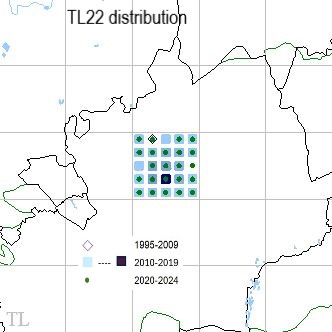
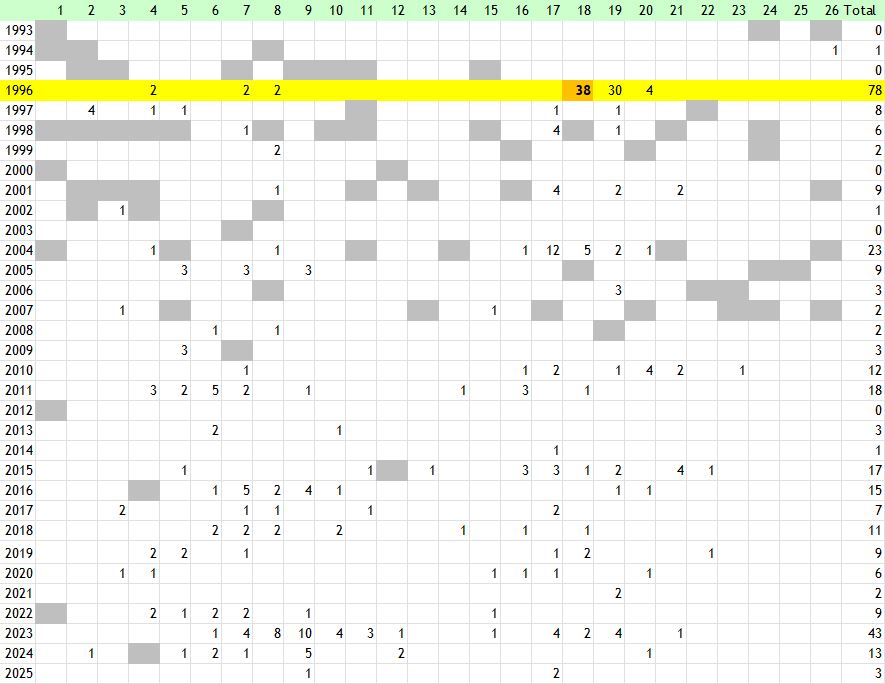
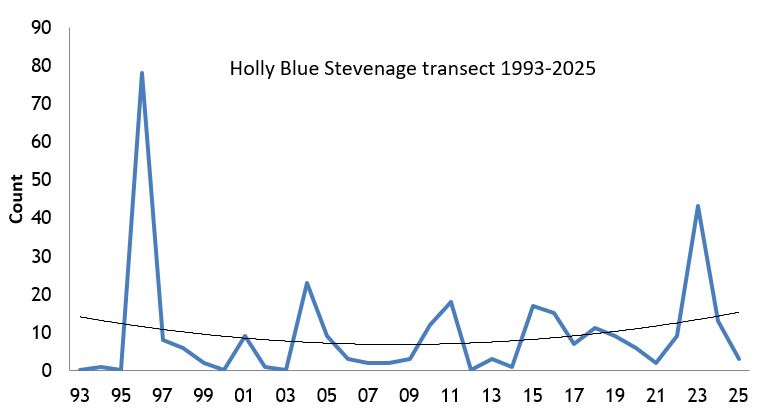
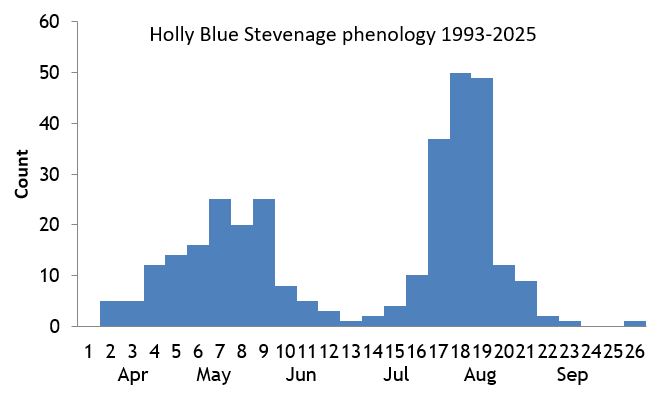




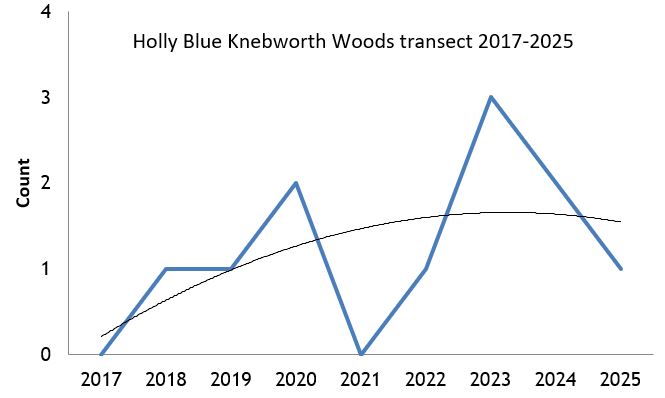
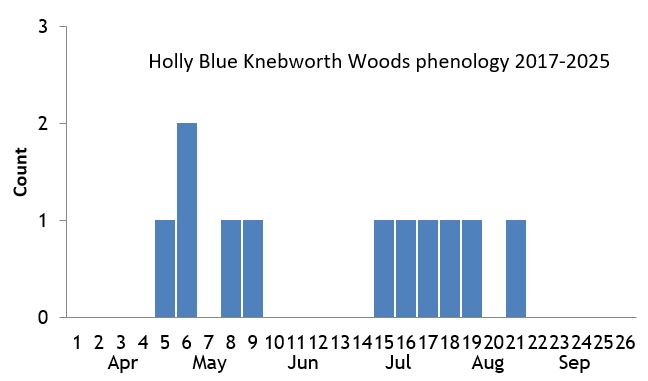
Earliest date: 20 March 2017 near Shephalbury Park
Latest date: 18 October 1997 at Watery Grove
The Holly Blue
produces two generations a year but a partial third brood is sometimes produced as in 1997, 2004, 2014 and 2019 when reports came in for October sightings.
The chart shows that the second brood may be larger but the last few years have indicated that both main broods are broadly similar in abundance. Eggs are laid singly on
unopened flower buds of any number of foodplants in the spring, and ivy in late summer. Larvae feed on the buds leaving holes which is a clue to their presence on neighbouring
buds. Larvae leave the foodplant when fully grown to pupate on the ground. Those which pupate from the late summer brood overwinter in this stage.
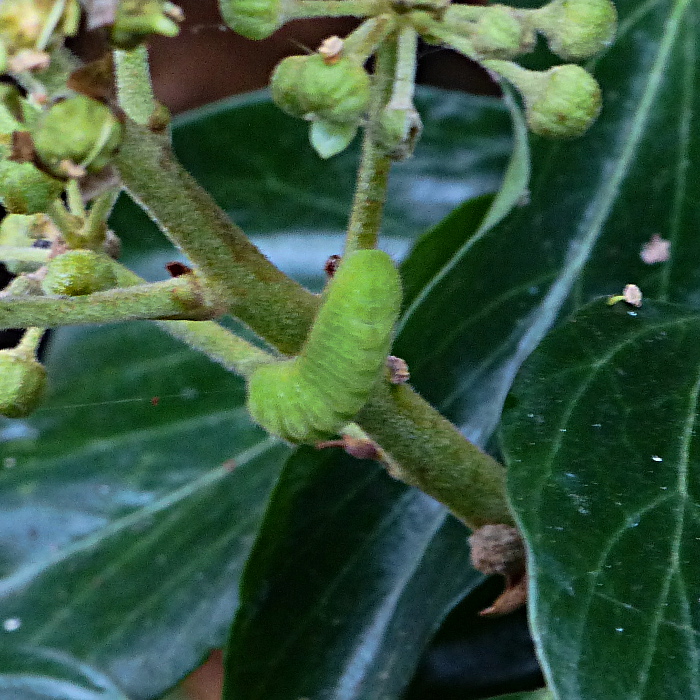
Larva Stevenage 30 Sep 2019
Unlike the other 'blues' in Britain, in some ways the Holly Blue behaves more like a 'hairstreak' as it frequents holly and ivy trees. Owing to its strong flight it can be frustrating to get a close-up view but if females are egg-laying then opportunities for taking a photograph are greater. It often basks with its wings half open in the early morning but later in the day they are usually closed. Males sometimes visit the ground on mud or puddles, and animal droppings.
There are aberrations regarding the amount of blue on the wings and the spot pattern on the undersides but I am unaware of any found in Hertfordshire.
Find out more on the UK Butterflies website